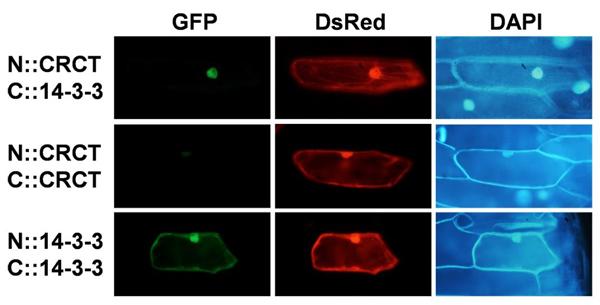Credit: Modified Fig. 9 of Fukayama et al. Plant, Cell & Environment (2021)
These research results were published in the international scientific journal Plant, Cell & Environment on May 14, 2021.
Main Points
- Plants convert carbon dioxide (CO2) into organic substances (such as starch) via photosynthesis. If a plant is growing in conditions where there is an elevated concentration of CO2, the amount of starch it produces increases.
- CRCT (*1) protein levels increase when CO2 concentrations are elevated. This protein has been thought to promote starch synthesis but how it does this was previously unknown.
- The research group revealed that 14-3-3 proteins (*2) play a role in CRCT-mediated regulation of starch synthesis.
- They indicated the possibility that CRCT moves into and becomes activated in the starch-storing parenchyma cells after being synthesized in the phloem’s vascular bundles.
- The researchers also revealed that CRCT binds to regulation sites on multiple starch synthesis-related genes and is a transcriptional activator protein.
- Synthesizing starch is a vital process for plants. The illumination of the regulatory mechanism behind this process will be useful for improving crop productivity and quality.
Research Background
The increased concentration of CO2 in the atmosphere is the main cause of global warming, which is a worldwide issue. However, it has been said that this could benefit plants as they convert CO2 into starch via photosynthesis. If a crop is grown in conditions where there is an elevated concentration of CO2, starch synthesis is accelerated, resulting in vigorous growth and increased yield. CO2-Responsive CCT protein (CRCT) is activated in conditions where CO2 concentration is high, however its function remained unknown. This research group has been investigating these proteins using rice plants, and previously discovered that CRCT is an important protein that regulates starch synthesis. In their latest findings, the group have revealed how CRCT regulates this process, which was not understood until now.
Research Methodology and Findings
Various proteins are required for starch synthesis in plants, including glucose 6-phosphate/phosphate translocator, ADP-glucose pyrophosphorylase, starch synthase and starch branching enzyme. The researchers hypothesized that CRCT regulates the expression of multiple genes corresponding to these starch synthesis-related proteins. Proteins that regulate gene expression are called transcription factors. In many cases, these transcription factors form a complex with another protein. When the researchers analyzed the volume of CRCT inside a plant, they discovered that it can form a complex with some types of protein. To investigate this further, they performed an analysis using an antibody that specifically binds to CRCT, which revealed that CRCT binds to 14-3-3 proteins. From another analysis, this time using green fluorescent proteins, the research group illuminated that CRCT and 14-3-3 protein form a complex inside the nucleus (Figure 1). They also indicated the possibility that CRCT moves into and becomes activated in the starch-storing parenchyma cells after being synthesized in the phloem’s vascular bundles. Furthermore, the researchers revealed that CRCT promotes transcription by binding to regions that regulate the expression of multiple starch synthesis-related genes.
It is known that there is a negative correlation between the expression of 14-3-3 proteins and the amount of starch. However, our results showed that there is a positive correlation between the amount of starch and the expression of CRCT. Consequently, the research group assumes that 14-3-3 protein and CRCT form an inactive complex (Figure 2).
Further Developments
Starch synthesis is indispensable for plants, and CRCT, which regulates this process, is a prime target for efforts to improve crop quality and productivity. In addition, CRCT is a gene that is activated under conditions where there is an elevated concentration of CO2, and this knowledge will be useful for selecting suitable rice cultivars for such environments in the future. Furthermore, similar genes to CRCT have been found in every plant investigated so far. The research group is also currently investigating CRCT function in potato, a staple starch crop.
From an academic standpoint, there are still questions that need to be answered. Looking at the current research results, it can be supposed that CRCT proteins move between cells but the underlying mechanism is not known. Furthermore, it is not understood how CRCT changes its own expression level in response to CO2 concentrations and sugar levels. If the mechanism behind CRCT-mediated regulation of starch synthesis can be fully illuminated, it will be possible to make even greater improvements to agricultural crops.
###
Glossary
1. CRCT:
CRCT stands for CO2–Responsive CCT protein. It is a protein found in plants, the accumulation of which increases if CO2 concentrations are high (or possibly in response to increased sugar concentrations). It is believed to promote starch synthesis.
2. 14-3-3 proteins:
A family of proteins that are expressed in the cells of all eukaryotic organisms (plants, animals etc.). They are known to play roles in signal transmission and metabolic regulation among other things.
Acknowledgements
This research received funding from the following:
- Japan Society for the Promotion of Science KAKENHI grant (JP22114511)
- Hyogo Science and Technology Association (31071)
Journal Information
Title:
“CO2-Responsive CCT Protein interacts with 14-3-3 proteins and controls the expression of starch synthesis-related genes”
DOI: 10.1111/pce.14084
Authors:
Hiroshi Fukayama 1,*, Fumihiro Miyagawa1, Naoki Shibatani1, Aiko Koudou1, Daisuke Sasayama1, Tomoko Hatanaka1, Tetsushi Azuma1, Yasuo Yamauchi2, Daisuke Matsuoka3, Ryutaro Morita1
1. Department of Bioresource Science, Graduate School of Agricultural Science, Kobe University.
2. Department of Agrobioscience, Graduate School of Agricultural Science, Kobe University.
3. Biosignal Research Center, Kobe University.
*Corresponding author
Journal:
Plant, Cell & Environment
Media Contact
Verity Townsend
[email protected]
Original Source
https:/
Related Journal Article
http://dx.





